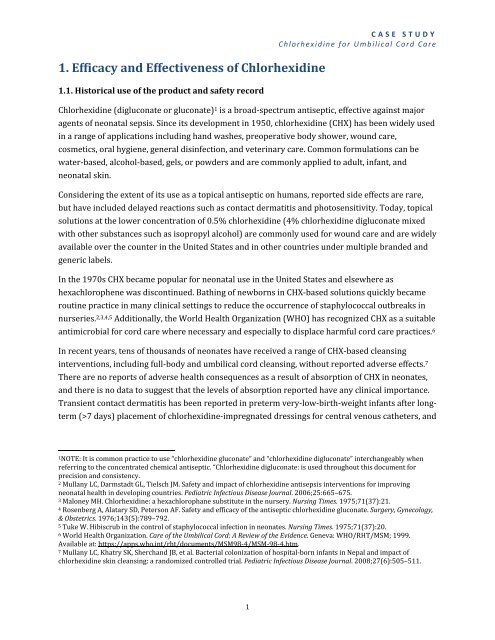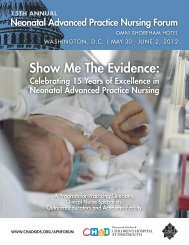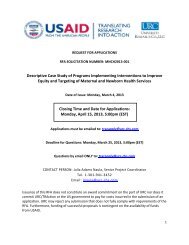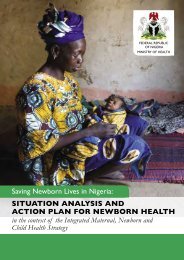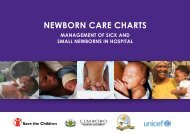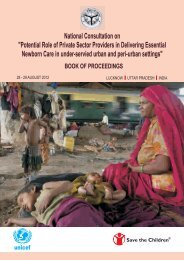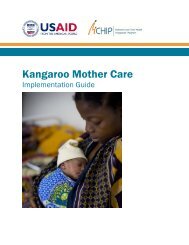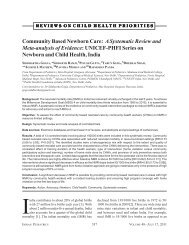Chlorhexidine for Umbilical Cord Care - Healthy Newborn Network
Chlorhexidine for Umbilical Cord Care - Healthy Newborn Network
Chlorhexidine for Umbilical Cord Care - Healthy Newborn Network
- No tags were found...
Create successful ePaper yourself
Turn your PDF publications into a flip-book with our unique Google optimized e-Paper software.
1. Efficacy and Effectiveness of <strong>Chlorhexidine</strong>1.1. Historical use of the product and safety recordCASE STUDY<strong>Chlorhexidine</strong> <strong>for</strong> <strong>Umbilical</strong> <strong>Cord</strong> <strong>Care</strong><strong>Chlorhexidine</strong> (digluconate or gluconate) 1 is a broad‐spectrum antiseptic, effective against majoragents of neonatal sepsis. Since its development in 1950, chlorhexidine (CHX) has been widely usedin a range of applications including hand washes, preoperative body shower, wound care,cosmetics, oral hygiene, general disinfection, and veterinary care. Common <strong>for</strong>mulations can bewater‐based, alcohol‐based, gels, or powders and are commonly applied to adult, infant, andneonatal skin.Considering the extent of its use as a topical antiseptic on humans, reported side effects are rare,but have included delayed reactions such as contact dermatitis and photosensitivity. Today, topicalsolutions at the lower concentration of 0.5% chlorhexidine (4% chlorhexidine digluconate mixedwith other substances such as isopropyl alcohol) are commonly used <strong>for</strong> wound care and are widelyavailable over the counter in the United States and in other countries under multiple branded andgeneric labels.In the 1970s CHX became popular <strong>for</strong> neonatal use in the United States and elsewhere ashexachlorophene was discontinued. Bathing of newborns in CHX‐based solutions quickly becameroutine practice in many clinical settings to reduce the occurrence of staphylococcal outbreaks innurseries. 2,3,4,5 Additionally, the World Health Organization (WHO) has recognized CHX as a suitableantimicrobial <strong>for</strong> cord care where necessary and especially to displace harmful cord care practices. 6In recent years, tens of thousands of neonates have received a range of CHX‐based cleansinginterventions, including full‐body and umbilical cord cleansing, without reported adverse effects. 7There are no reports of adverse health consequences as a result of absorption of CHX in neonates,and there is no data to suggest that the levels of absorption reported have any clinical importance.Transient contact dermatitis has been reported in preterm very‐low‐birth‐weight infants after longterm(>7 days) placement of chlorhexidine‐impregnated dressings <strong>for</strong> central venous catheters, and1NOTE: It is common practice to use “chlorhexidine gluconate” and “chlorhexidine digluconate” interchangeably whenreferring to the concentrated chemical antiseptic. “<strong>Chlorhexidine</strong> digluconate: is used throughout this document <strong>for</strong>precision and consistency.2 Mullany LC, Darmstadt GL, Tielsch JM. Safety and impact of chlorhexidine antisepsis interventions <strong>for</strong> improvingneonatal health in developing countries. Pediatric Infectious Disease Journal. 2006;25:665–675.3 Maloney MH. <strong>Chlorhexidine</strong>: a hexachlorophane substitute in the nursery. Nursing Times. 1975;71(37):21.4 Rosenberg A, Alatary SD, Peterson AF. Safety and efficacy of the antiseptic chlorhexidine gluconate. Surgery, Gynecology,& Obstetrics. 1976;143(5):789–792.5 Tuke W. Hibiscrub in the control of staphylococcal infection in neonates. Nursing Times. 1975;71(37):20.6 World Health Organization. <strong>Care</strong> of the <strong>Umbilical</strong> <strong>Cord</strong>: A Review of the Evidence. Geneva: WHO/RHT/MSM; 1999.Available at: https://apps.who.int/rht/documents/MSM98‐4/MSM‐98‐4.htm.7 Mullany LC, Khatry SK, Sherchand JB, et al. Bacterial colonization of hospital‐born infants in Nepal and impact ofchlorhexidine skin cleansing: a randomized controlled trial. Pediatric Infectious Disease Journal. 2008;27(6):505–511.1


